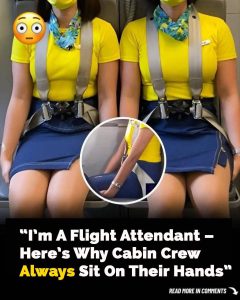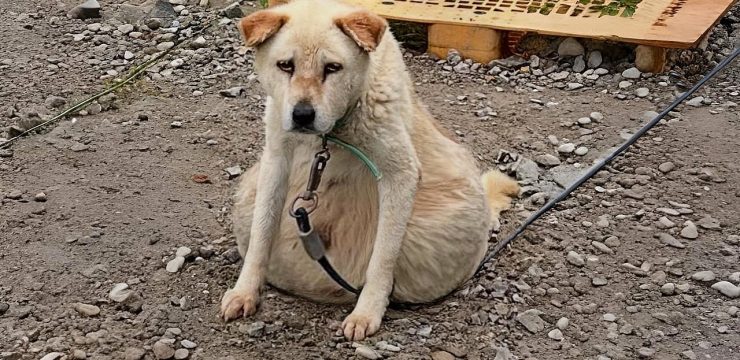If you’ve ever flown on a commercial airplane, you may have noticed something curious: flight attendants often sit on their hands during takeoff and landing. While this may seem like an unusual habit, it is actually a safety measure designed to protect both the crew and passengers. Flight attendants are not only responsible for serving snacks and beverages; they are highly trained safety professionals prepared to handle emergencies and ensure the well-being of everyone on board.

One particular safety protocol that often catches passengers’ attention is the bracing position flight attendants assume during these critical phases of flight. Recently, Henny Lim, a flight attendant from Cebu Pacific, a Philippine airline, shed light on this lesser-known procedure in a TikTok video that quickly gained traction. In the video, she asks, “Have you ever wondered why cabin crew adopts this position during takeoff and landing?” She then demonstrates the bracing position while seated in her jump seat.
Takeoff and landing are the most critical phases of any flight, with a higher likelihood of incidents occurring during these times. Should an evacuation become necessary, the bracing position allows crew members to respond swiftly and efficiently. According to the video’s voiceover, this position involves fastening seatbelts securely, sitting upright, placing hands beneath the thighs, relaxing the arms, and ensuring both feet are flat on the floor. The clip, which has recently regained popularity after being shared in 2022, provides insight into the importance of this posture.
In the demonstration, Henny and a fellow crew member show how they secure themselves by tucking their hands under their thighs. This technique is crucial because it helps keep their arms and hands stable, minimizing involuntary movements caused by turbulence, hard landings, or sudden jolts. By reducing unnecessary motion, flight attendants can maintain their readiness to assist passengers immediately if needed. The video emphasizes that the primary goal is to maintain a rigid position so that, in the event of an unexpected emergency, the body is less susceptible to injury. Limiting movement during impact can significantly reduce the risk of harm, ensuring that flight attendants can quickly spring into action when necessary.
During takeoff and landing, flight attendants also conduct what is known as a “silent review.” This mental checklist helps them prepare for potential emergencies, ensuring they are ready to act without hesitation if required. Before the video concludes, viewers hear a reassuring message: “Safe flight, everyone.”
Despite the popularity of the video, it is important to note that sitting on one’s hands is not a strict regulation. A seasoned flight attendant shared with Reader’s Digest that this practice is more a matter of personal preference than an official rule. While it is essential to position the hands correctly in the brace position, individuals can choose to sit on their hands if they prefer. According to Erin Thomas, a flight attendant with over 15 years of experience, the key rule is to avoid holding onto the harness. “The brace position is what really matters,” she explained.
Erin mentioned that she personally prefers to rest her hands on her lap. “It helps me appear calm,” she noted. Since passengers often take their cues from the crew, maintaining a composed demeanor during takeoff and landing can help create a sense of reassurance and ease. While the stance may appear rigid, it plays a vital role in preventing injuries and enabling crew members to assist passengers immediately after an impact.
Understanding why flight attendants sit on their hands offers valuable insight into the numerous safety measures in place during air travel. Every aspect of their training is designed to maximize passenger safety and ensure that they can respond effectively in any situation. The bracing position is not just about protecting themselves—it is about being ready to help others in the event of an emergency.
Beyond their physical posture, flight attendants are constantly assessing their surroundings and monitoring passengers to identify any potential issues. Their silent review during takeoff and landing includes visualizing emergency scenarios, mentally reviewing evacuation procedures, and considering the best ways to assist passengers with different needs. This level of preparedness ensures that they can act decisively and confidently if a situation arises.
The practice of sitting on their hands is a small but significant part of this preparation. By limiting their own movements, flight attendants reduce the risk of injury, allowing them to remain fully functional and ready to assist passengers. In high-stress situations, even a momentary delay can make a difference, so maintaining a position that minimizes the impact of sudden jolts is essential.
While not all airlines require flight attendants to sit on their hands, the practice has become a common choice among crew members worldwide. It reflects their commitment to prioritizing safety and their readiness to respond to any emergency that may arise. The next time you notice a flight attendant assuming this position, you’ll know that it is part of their dedication to ensuring a safe and secure flight for everyone on board.
So, have you ever wondered why flight attendants sit on their hands? Now that you know the reasoning behind this practice, you can appreciate the level of care and preparation that goes into every flight. Whether it’s through their bracing position, silent reviews, or calm demeanor, flight attendants play a crucial role in ensuring that passengers reach their destinations safely. The next time you fly, take a moment to recognize the dedication and expertise of the crew members who work tirelessly to keep you safe. After all, their readiness and quick response can make all the difference in an emergency situation. Safe travels, and remember to trust the professionals who are there to ensure your journey is both comfortable and secure.





